Planting cherries in the spring: terms and rules for planting seedlings in open ground
Say what you like, and who does not like to feast on delicious cherries. And if earlier it was believed that sweet cherry is a southern crop, now a sufficient number of varieties have been bred that can be grown in cooler conditions of the same Middle zone. Therefore, now more and more summer residents are trying to grow this stone fruit crop in their area. However, in order for the sweet cherry to bear fruit regularly and abundantly, it must be planted according to all the rules.
Next, you will learn how to choose a good seedling, find the most suitable place in the garden, prepare a planting hole and plant cherries correctly in the spring, and also what to do next in order to start getting decent harvests soon.
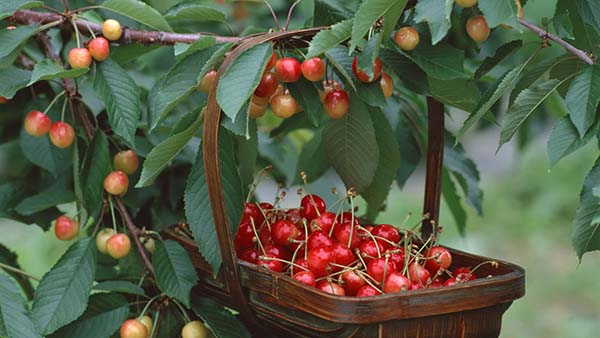
Content
- 1 When to plant cherries in spring, in what month: optimal timing
- 2 Step-by-step instructions for planting cherries in spring
- 2.1 Selecting a seedling and preparing it for planting
- 2.2 Suitable place in the garden
- 2.3 The need for pollination
- 2.4 Planting scheme: at what distance to plant
- 2.5 Required soil
- 2.6 Preparation of the landing pit (its dimensions, depth)
- 2.7 How to prepare a nutrient mixture (substrate) or how to fill a planting hole
- 2.8 Direct planting of a seedling
- 3 Rules for further care of cherries after spring planting
When to plant cherries in spring, in what month: optimal timing
The optimal time for planting sweet cherries in the spring in the garden is the period before the budding of the tree, in other words, before it enters the growing season (i.e., the plant must still sleep).
At the same time, an important condition for spring planting is a positive air temperature, not only during the day (it should already be +5), but also at night.
You should not wait for the ground to completely thaw out; it is very good to plant seedlings with an open root system immediately after the snow melts, but the ground has not yet had time to warm up very much.
Thus, it is highly desirable to have time to plant while the seedlings are still "dormant", otherwise it will definitely negatively affect their survival rate and disrupt their natural development cycle.
As for the approximate dates, depending on the climatic characteristics of the region, spring planting of sweet cherries is recommended from late March-April to early-mid-May.
Advice! The best time to plant seedlings is cloudy and calm weather: early morning or late evening.
Timing for different regions
Each climatic zone has its own weather characteristics, so the timing of spring planting of sweet cherries in different regions will necessarily differ:
- So, in the south of Russia, cherry seedlings can be planted in open ground in the second half of March and early April.
- In the Middle Polos (Moscow region), cherries are planted not earlier than the second half of April.
- In Siberia and the Urals, spring planting of sweet cherries is carried out in late April-early May.
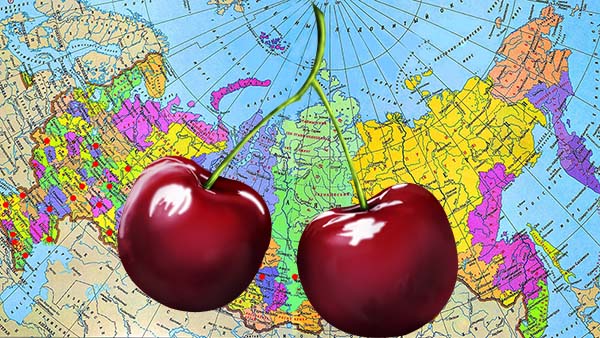
According to the lunar calendar in 2020
Choose the optimal date for planting seedlings can help you moon calendar.
So, favorable days for spring planting of cherries in 2020, according to the lunar calendar, are:
- in March - 26-29;
- in April - 11-15, 24, 25;
- in May - 2-10.
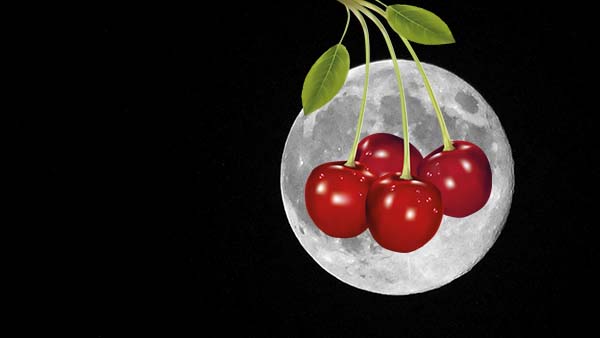
A banal thing, but it is not always possible to get to the dacha on the appropriate days, so the main thing is not to plant cherries and any other crops on unfavorable dates according to the lunar calendar - the days of the New Moon and Full Moon, as well as the period when the Moon is in Aquarius, because ... it is a barren and dry sign - in italics.
Unfavorable days, according to the lunar calendar for 2020, for planting cherry seedlings in spring, the following dates are:
- in March - 9,19-21, 24;
- in April - 8,15-17, 23;
- in May - 7,13-14, 22;
- in June - 5,9-11, 21.
According to the lunar calendar, from the magazine "1000 Tips for Summer Residents".
When is it better to plant - in spring or autumn
Important! Too late to plant seedlings in the autumn is also not recommended, because shoots must have time to mature well in order to successfully survive the winter.
However, if, God forbid, you are late, and frosts are expected within 1-2 weeks, then it is better to play it safe and postpone the planting of cherries until spring (you can save the seedling by digging it in the garden or planting it in a container and putting it in the basement).
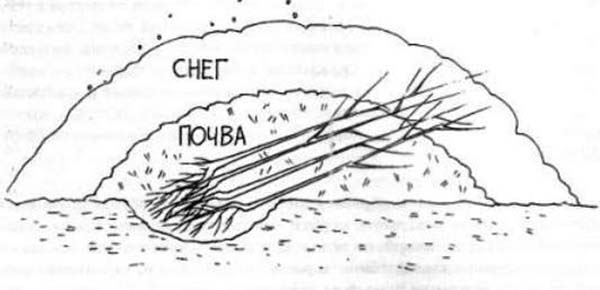
Alternative opinion
However, if you are a resident of the South of Russia, then this is not important for you. It is a different matter if you are a representative of a region with a more severe climate (zones of risky farming).
- In the process of growing a seedling during the spring-summer period, you will be able to quickly respond to possible problems (diseases, pests, lack of moisture) and immediately take the necessary measures to eliminate them.
- The spring supply of moisture in the soil allows the root system to adapt faster after planting and begin active growth.
- You have the opportunity to prepare the site in advance, even in the fall, so that the soil in the planting pit has time to settle by the spring, which will help to avoid burying the root collar.
Note! Cherry seedlings with a closed root system can be planted all year round - from April to October, unless it is recommended to do this in the middle of summer, when it is very hot.
Step-by-step instructions for planting cherries in spring
The main condition and the main guarantee of good survival of the tree is its correct planting, which includes the choice of a suitable place for growing in the garden, as well as the preparation of the planting pit.
Video: how to plant cherries correctly
Selecting a seedling and preparing it for planting
It so happened that when buying any seedling, you should always do opting for zoned varietiesthat have worked well when grown in your climate zone.
Worth knowing! Saplings can be either with an open root system (OCS), and with a closed one (in a container).
Of course, it is better for beginners to take seedlings in a container (although they are more expensive), and experienced gardeners can also purchase them with ACS.
So, a high-quality cherry seedling should have the following characteristics:
- General appearance seedling should be healthy, without signs of wilting, damage by diseases or pests.
- The seedling itself must be not older than 2 years, since at this age the seedlings adapt faster to a new place.
- Height seedling should be within 1-1.5 m: Any deviation up or down indicates improper care or excessive nitrogen fertilization.
Another thing is that some sellers immediately sell cut seedlings, but this is rare.
- The seedling must have well developed root system (without any growths and neoplasms), that is, in addition to the main root, there should be several lateral ones (the older the seedling, the more roots it has), the length of which can be about 20-25 cm, while they should not be overdried and broken.
By the way! Even if you are buying a closed-root seedling, the lateral roots tend to stick out of the container.
Advice! To check that the seedling is indeed with a closed root system, you need to take it by the trunk and shake it. If he sits tightly - everything is fine, if not, then something is wrong here ...
- At the bottom, on the trunk, you should clearly see vaccination site (connections of rootstock and scion), which will guarantee that this is a varietal tree, and not wild.
As a rule, the vaccination is done by budding method by a kidney (they also say "grafted with an eye"), less often by a graft (ie copulation).
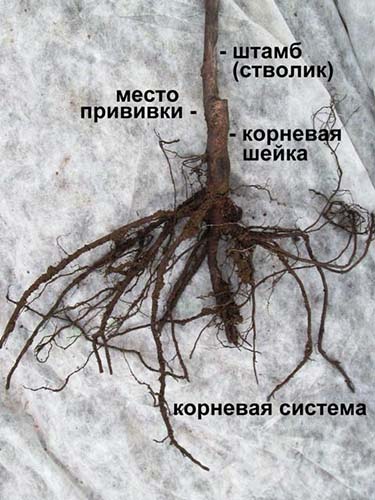
- It is also worth evaluating the quality of the upper part of the trunk (grafted part): the wood must be ripe and strong, without any mechanical damage, sunburn, frost cracks and cracks in the bark. And you the trunk must be straight and not bent.
Note! If the bark on the trunk peels off in places without damaging its integrity, then this is a sign of improper storage of the seedling in winter, which led to its freezing.
- It is highly desirable that the seedling did not show any signs of the beginning of the growing season, i.e. was at rest, which means that his kidneys should still be sleeping (i.e.there should be no leaves on it).
However, seedlings with a closed root system (in containers) in the spring are often sold already in the growing season, which is quite normal. Therefore, in this case, you also need to carefully evaluate their appearance, especially the color of the leaves.
Video: how to choose cherry seedlings
Preparing for landing
If you want to properly prepare the seedling for planting, then you will need to know that immediately before planting, the roots of the cherry seedling should be washed from the old soil, then dipped in a clay mash, and then renewed their tips, slightly trimming.
Important! This (updating the tip of the roots by cutting them) is all the more necessary if the roots are too long, or you will notice that there are damaged, diseased or broken ones (in this case, they need to be cut to a healthy place).
Some gardeners recommend completely soaking the seedling in water (with the addition of Kornevin) for a day or at least an hour. This will help restore biological processes in the roots and saturate them with moisture, especially if you see that the roots are slightly dry (and this should never be allowed).
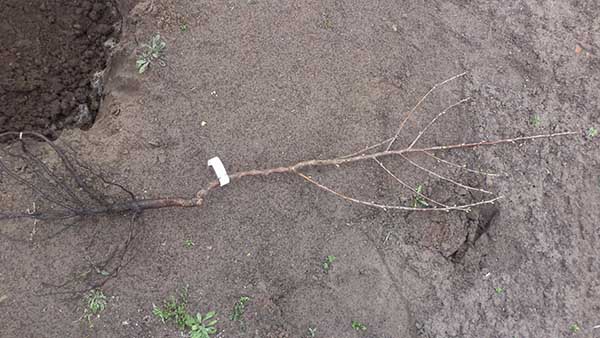
Suitable place in the garden
Sweet cherry is a warm and light-loving stone fruit crop that will grow well only in open and well-lit warm areas of the garden.
An ideal option for planting cherries would be a place that, on the north side, will be protected from the drying winter winds (this could be your country house, some kind of outbuilding or fence), while the tree itself, naturally, it should be placed on the south side (or at least from the south-west or west) so that during for it receives the maximum amount of sunlight.
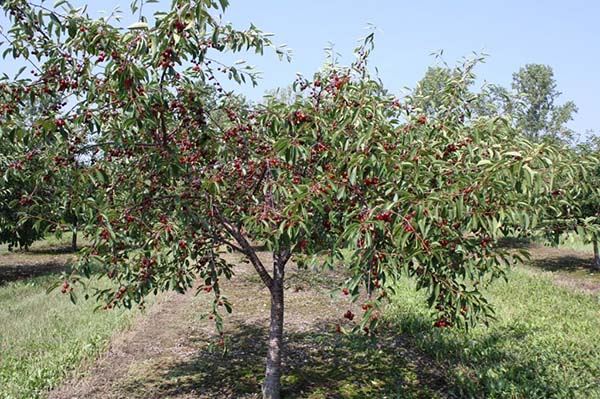
It would be an unforgivable mistake to plant cherries in lowlands or strong wetlands. In other words, at the landing site moisture should not stagnate in the springwhen the snow melts. Otherwise, the plant will simply underpin the root collar, and it will die.
It is worth considering! Stone fruit crops (apricots, peaches, cherries, sweet cherries) are crops with relatively "weak" root collars (compared to seed crops, the same apple trees), therefore, in the zone of risky farming, they are recommended to be planted on elevations (mounds).
The occurrence of groundwater in the site intended for planting should be at a level of 1.5 m from the ground surface.
If the groundwater is close, then you have no choice but to make an artificial embankment and plant a seedling on it.
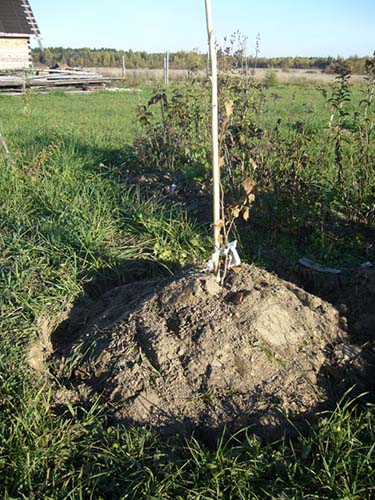
Important! You should not plant cherries near large spreading trees (especially nuts), as this always negatively affects their growth and productivity (if the seedling can generally grow and bear fruit normally).
The need for pollination
Sweet cherries, like cherries, require cross-pollination (since the culture is self-fertile), in other words, you need to plant at least 2, and preferably 3 different varieties next to each other (the same varieties are not suitable for pollination), and always of the same flowering period.
Alternatively, you can plant cherries next to the cherry (excellent pollinator) or not far from a neighbor's tree.
By the way! There are also self-fertile varieties that do not require pollination, but for their better pollination, it is still better to have another variety of cherries or cherries nearby.
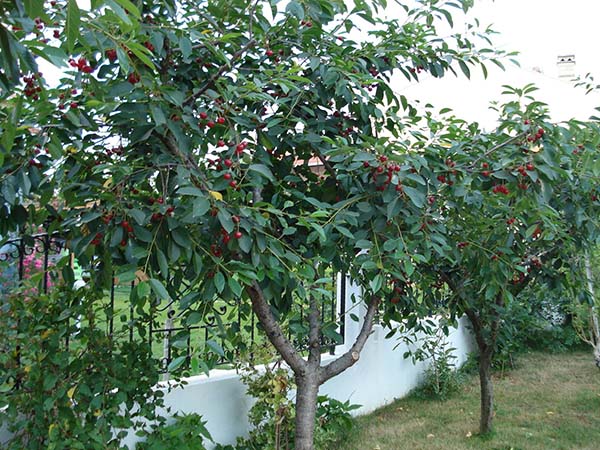
Planting scheme: at what distance to plant
Sweet cherry, like any other fruit tree, needs its own individual space, so when planting, it is worth keeping a distance between neighboring crops.
As a rule, cherries are planted at a distance of 3-4 meters between rows and 3-4 meters in a row.
Remember! The closer you plant trees, the more difficult it will be for you to control their crown in the future, in other words, you will need regular and mandatory pruning, including summer pruning.
Required soil
The soil is the soil of strife, so loamy (loam) and sandy loam soil, as well as light black soil, are perfect for growing cherries.
The soil must be sufficient fertile, light and loose (it is good to pass water and air to the roots) and have slightly acidic, close to neutral, acidity level.
Worth knowing! All stone fruits love non-acidic soils and will thrive better in alkaline soils (7-7.5 pH) than even relatively acidic (5.5 pH).
Of course, a less successful option for planting cherries (and almost all fruit trees) is sandy and clayey soil.
Important! When planting a seedling in excessively sandy soil, add a little clay and more compost to it, and sand in clayey soil, this will help balance the composition of the soil.
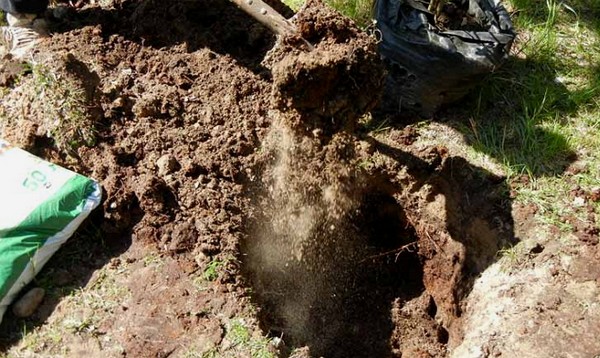
Advice! In a cold and harsh climate, as well as if the land is heavy, or the site is very waterlogged and the groundwater lies very close, then cherries (like any other fruit trees) are recommended to be planted on gentle hills ("According to Zhelezov").
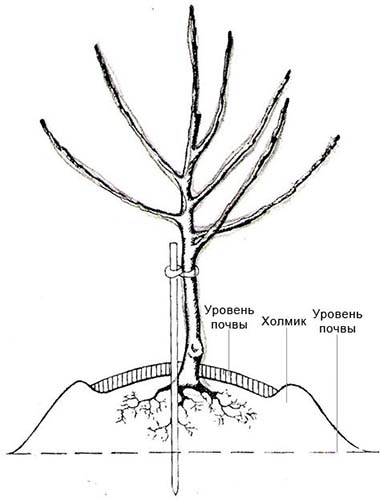
Preparation of the landing pit (its dimensions, depth)
It will not be superfluous to note that the planting pit for spring planting of cherries must be prepared in advance. It is best to do this in the fall or at least 1-2 weeks before planting the seedling. During this time, the soil will just have time to settle to the desired level.
Important! When digging a planting hole, the top layer of soil is thrown aside for further use.
Width (diameter) and depth of the planting pit for cherries should be within 50-80 cm. Moreover, the walls of the recess should not taper downward, it is better to make them vertical.
By the way! As a rule, on average, they dig a hole of 60 by 60 cm.
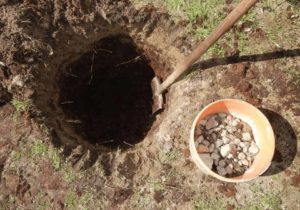
And here is a planting hole for a seedling closed root just do 2-3 times larger than the container itself.
If necessary, it is immediately laid on the bottom drainage layer 5-15 cm from broken brick or small stones (it is optimal to use lime or chalk crushed stone, which contains a lot of calcium and which deacidifies the soil = lowers its acidity), and then the prepared nutrient mixture is poured.
Important! If you have to plant in clay soil, then, in addition to the obligatory drainage layer, you also need to dig the deepest hole possible.
How to prepare a nutrient mixture (substrate) or how to fill a planting hole
So that cherries can easily adapt to a new place and strengthen for further growth, it is recommended to fill the planting pit with a nutrient substrate when planting, in other words, add the whole range of macro- and partly microelements.
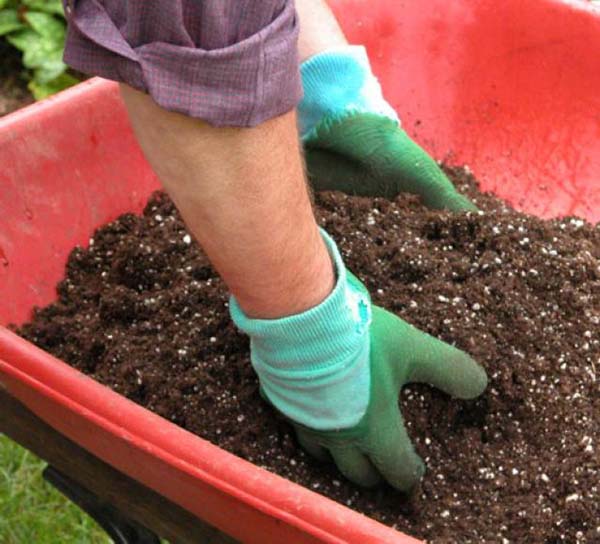
For this, the planting pit is filled with a specially prepared soil mixture (which is thoroughly mixed to a uniform consistency), which may include the following components (mineral and organic fertilizers):
- all the top fertile soil (upper 20-30 cm), which you removed when digging a hole;
- a bucket (8-9 kg) of good humus or compost;
Additionally:
a bucket (8-9 kg) of non-acidic peat (either at will, or in case you have sandy soil);
a bucket (8-9 kg) of sand (if you have relatively heavy soil);
- 1-2 cups (200-500 grams) superphosphate or 400-600 grams of bone meal (organic phosphorus fertilizer);
- half or 1 cup of potassium sulfate (100-200 grams) or 2-4 cups (200-400 grams) wood ash (organic analogue of potash fertilizer).
Either instead of superphosphate and potassium sulfate, just use 300-400 grams of nitroammophoska (it contains 16% nitrogen, phosphorus and potassium) or, even better, diammophoska.

Worth knowing! When planting a tree (even in spring), it is not necessary to specially add nitrogen fertilizers (another thing if it is a complex fertilizer), since they stimulate the growth of the aboveground part to the detriment of the development of the root system (especially when planting in northern regions).
Important! However, many knowledgeable gardeners do not recommend at all to lay mineral fertilizers in the planting pit, but to apply them in the future and already as top dressing.
After filling the pit with a nutrient substrate in its middle, it is necessary drive in a wooden peg, which will further serve as a support for a young seedling.
If you do not tie a young seedling to a peg, then when leaves grow on it, then, due to the high windage, strong winds will sway the trunk and cut off young roots.
Direct planting of a seedling
Step-by-step instructions for spring planting of cherry seedlings in open ground:
- Fill the planting hole with fertile soil in advance, leaving a depression in the size of the seedling root system.
Further, if desired (many water it only after planting, others both before and after, in other words, as you like best), you can slightly spill the hole filled with nutrient soil with water.
- If you are planting a seedling with an open root system (ACS), then you need to add a small mound in the center of the planting hole.
But if you are planting a seedling with a closed root system (ZKS), then you do not need to make any mounds, but simply plant it in a prepared planting hole without disturbing the earth's coma.
- Drive in a wooden support or peg (if you have not done so beforehand).
If you do not tie a young seedling to a peg, then when leaves grow on it, then, due to the high windage, strong winds will sway the trunk and cut off young roots.
- Place the seedling in the center of the mound and spread the roots along its (mound) sides down (the roots should in no case bend and stick up!).
Important! If you have a seedling that was grafted with an eye (budding), the place of budding (eye = new shoot that has grown from the grafting) should face north, and the place of cut should be towards the south.
- Cover with earth, while shaking the seedling to eliminate voids between the roots.
- Compact (tamp) the soil, starting from the edges at the base of the seedling.
At the same time, do not confuse the root collar (the place where the first root originates from the trunk) with the grafting, which is located higher - on the trunk) and should be located 3-5 cm (you can simply attach 2-3 fingers) above the soil surface. After the tree settles in loose soil, the root collar will in any case take its normal position.
Attention! But if you deepen the root collar, then the tree will grow poorly and gradually die (because the root collar will shake out). On the contrary, plant it too high, the roots of the seedling will be exposed and may simply dry out in the summer heat or freeze in winter.
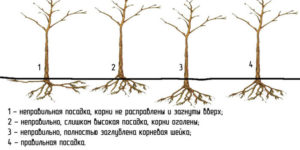
- Next, you need to make a hole (roller) along the diameter (perimeter) of the trunk circle 5-10 cm high.
- Spill abundantly with water, pouring out at least 2-3 buckets (pour out gradually - wait for it to be absorbed and add more).
- Tie the seedling to the prepared support with a soft twine and secure in the correct position.
- Smooth out the roller, loosen the soil in the trunk circle and mulch it with peat, humus or compost.
Mulch will help to avoid drying out the roots and excessive evaporation of moisture.
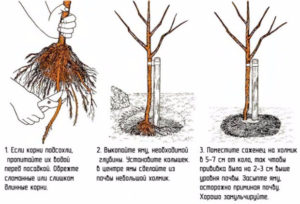
Note! Mulch should not be laid close to the stem of the seedling, as this can cause the bark to undergo heating, and, consequently, cause the development of fungal diseases.
In any case, the grafting site should be above the mulch.
Video: planting cherries in spring
Rules for further care of cherries after spring planting
It is advisable immediately after planting a cherry seedling without fail trimto level the root system with the aboveground part (this is done for a kind of "reanimation" of the seedling after planting, since any planting and transplanting is a severe injury and stress for the plant).
Advice! How to do it correctly (start shape cherries), read in our article on spring cherry pruning.
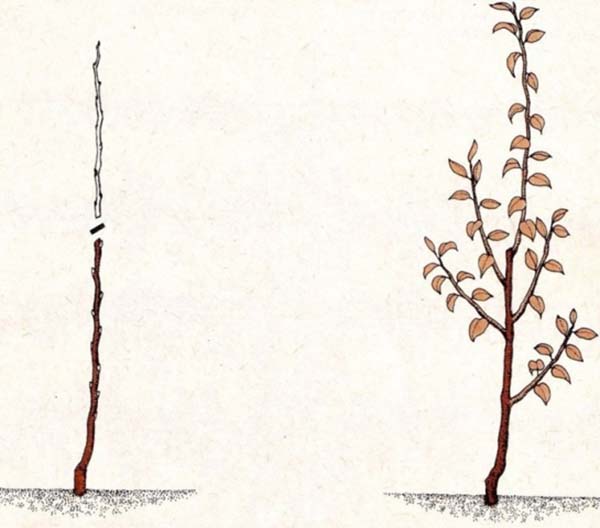
Video: planting cherries and initial pruning, as well as tips for buying a seedling
Further, a young tree will require careful post-plant care from you, aimed at creating optimal conditions for its early adaptation (survival) in a new place.
So, the main condition for the successful rooting of cherries is a sufficient amount of moisture in the soil.Therefore, if the weather is dry, then after planting it is required to carry out timely and regular waterings (1-2 times a week), pouring out 2-3 buckets of water. In the future, watering will need to be carried out as needed, depending on the weather conditions (in spring and autumn, you can water 2-3 times a month, and in summer, during a hot and dry period, once a week). And then (after each watering), if you have not mulched the near-stem circle, be sure to loosen the soil at the base to improve oxygen access to the roots. Also, at the same time as loosening, you can weed the near-trunk circle from weeds.
By the way! It is possible to determine that the earthen lump has dried out and the cherries urgently need watering as follows: dig a hole deep into the bayonet of a shovel, take a handful of earth from the bottom, if it is dry, then water it urgently.
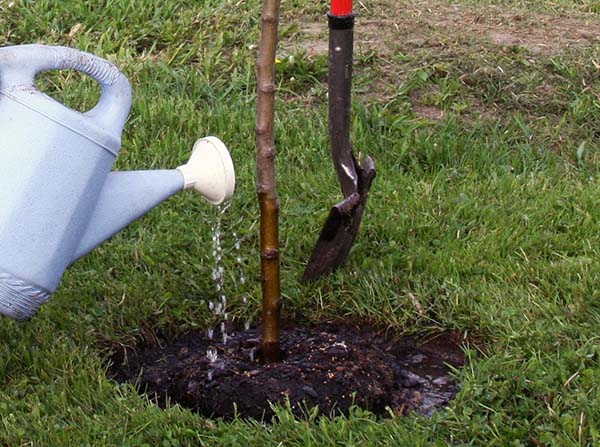
Advice! Either make a new hole every year, or initially dig not very deep so that moisture does not accumulate in it in the winter-early spring period and the root collar does not get wet.
Additional dressings this year it will no longer be needed, since we have already brought in all the necessary food at landing, and it should be enough for the next couple of years.
Of course, you need to carefully follow behind the state of your tree, so that suddenly did not attack any pests and hit dangerous diseases.
The main scourge (the most dangerous and annoying disease), which often affects cherries (however, like other stone fruits) is coccomycosis.
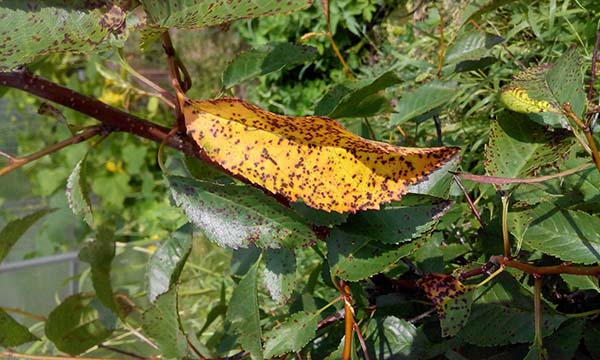
By the way! The site has a detailed article about how to properly spray fruit trees and berry bushes in spring against diseases and pests.
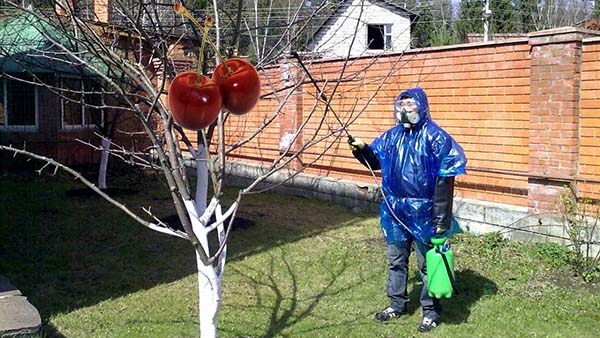
Also, don't forget correctly prepare (cover, mulch) cherries for winter.
And next spring, you will again have to perform a series of standard care activities for your stone fruit crop.
Advice! The site has a general article about spring care for cherries.
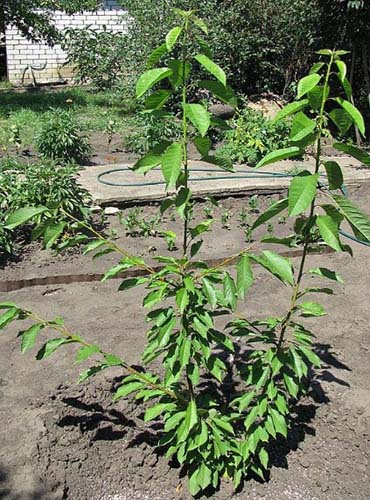
You should be ready! Different birds are very fond of eating cherries, so you should definitely put at least scarecrow (garden scarecrow) or hang shiny tapes and CDs directly on wood.
Thus, strict adherence to the rules and recommendations for the spring planting of cherries is a guarantee that the stone fruit crop quickly adapts to a new place, takes root easier and grows. As a result, in a few years it will be possible to harvest your own fruit from this tree.

